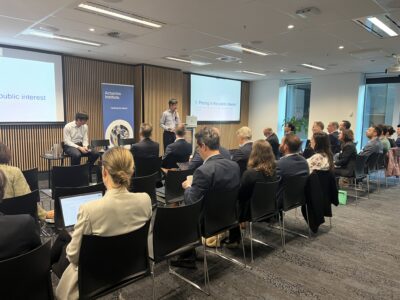
2024 Life Insurance Appointed Actuaries Forum
Good isn’t good enough – best estimate is ‘best’ for a reason.
This is a key area that our profession needs to focus on maintaining to uphold our responsibility to the industry. To achieve that, we need to stay on top of the changing environment in which we operate and make sure key issues are factored in when we advise on what is truly best estimate.

On 30th May, the Actuaries Institute hosted Appointed Actuaries (AA) and their representatives from across the life insurance industry at the 2024 AA Forum. Chris Scheuber led an insightful morning of discussion that covered several key topics that are critical to the sustainability of the industry.
2024 Actuaries Institute President, David Whittle, opened the event, highlighting the importance of discussing areas of concern and the responsibility of the Appointed Actuary role to help shape the insurance sector, to ensure its sustainability and to maintain public trust. According to David,
“Actuaries need to use their expertise to safeguard the industry and to engage, challenge one another and to learn from each other.”
Among the many emerging risks that have come to the fore post-COVID-19 are pricing in the public interest, climate risk and the design and sustainability of the lump sum morbidity products. Focusing on these three key areas, speakers Peter Baker, Stephanie Wong, Stephen Hungerford and Greg Barn led the discussion and shared their key insights.
While artificial intelligence was acknowledged as a critical topic, there simply wasn’t enough time on the agenda to fully explore this. Yet, it naturally crept into every conversation as it begins to define the industry landscape.

Pricing in the public interest
Recent industry issues across multiple practice areas, including significant changes in community and regulatory expectations, and technology and data advancement all highlighted issues in established practices. Peter Baker, Chapter Lead for Actuarial Advice and Pricing at Resolution Life, discussed the key principles to pricing in the public interest and their application:
- Transparency and disclosure and what this means practically. Does this lead to information such as profit margins and internal pricing philosophies being disclosed?
- Value for money and affordability which will always be a key consideration.
- Anti-discrimination and fairness taking into consideration the relevant legislation and community expectations.
- Responsible and appropriate use of data with a focus on the recent developments in genetic testing technology and how genetic test results are appropriately used.
- Avoiding perverse incentives and how we address moral hazard through product design while bearing in mind significant medical advancements.
- Sustainability and how this equates to stability from the consumer’s point of view.
The forum considered how Appointed Actuaries need to apply these principles and work with others in the business to ensure they are applied consistently across all areas. There is strong agreement that the risk and legal functions play a pivotal role.
The question of how we set reasonable expectations with consumers was also raised.
This is a difficult area to define, even after taking into account legal requirements.
APRA/ASIC’s Joint Letter on Premium Increases in Life Insurance, December 2023[1] highlights current concerns. It also highlights expectations moving forward around pricing and rerating, product design and marketing and disclosure, and is an important resource to guide future thinking.
This underscores the importance of Appointed Actuaries keeping the Code of Conduct ‘front of mind’ in all they do. The Code encompasses the principles to observe “in the public interest and to build and promote confidence in the services provided by actuaries and in the actuarial profession.”
Advice on climate risks for life insurers
Stephanie Wong, Manager of Climate and Insurance Modelling at Suncorp Group, led the discussion on what Appointed Actuaries need to be considering when it comes to climate change.
As an important starting point, she referenced the Climate Change – Technical Paper for Appointed Actuaries [2] which informs and educates members about climate risks and opportunities. At what point do we transition climate risk from an emerging risk to something that needs to be quantified now and for which we make explicit adjustments?
It is difficult to incorporate a ‘long, slow-moving risk’ into forward-looking assumptions without more data to allow predictions for how this will play out (particularly in life insurance, where teasing out any correlations with mortality and morbidity is challenging as compared to general insurance risks where impacts will come through faster, e.g., natural perils).
Allowing for interactions between emerging climate risks is also proving challenging. The lack of certainty makes quantitative allowance difficult; however, Stephanie presented scenario analysis[3] that is useful in displaying the risks that companies need to be considering. Qualitative assessments with high-level directional impacts can allow management to assess a company’s resilience and advanced modelling capabilities can determine which factors are going to be most relevant when predicting the future.[4]
Measuring product design riskiness for lump sum morbidity
For the final topic of the forum, Stephen Hungerford (Senior Pricing Actuary at Clearview) and Greg Barn (Head of Actuarial R&D at Hannover Life Re Australasia) delved into the future sustainability of TPD and trauma products.
Are these products at risk and, if the answer is yes, then why? When these products are considered, their purpose needs to be clearly identified. Board and senior management need to be advised on the product features and the risks need to be highlighted. Greg explored how a sustainability rating process can be used to assess design features and benefits against key insurability principles.
APRA expects the market to take the lead on future sustainability and it is going to ultimately come back to these core features and principles (set out in the IDII Sustainability Guide[5]). There may be merit in committing resources to investigating whether new products better connect to new generations of customers and meet their expectations around what lump sum morbidity products should provide.
Looking forward
The session concluded with an open discussion on any additional areas that should be a key focus. Most of the attendees’ attention was focused on the regulation of genetic test results in life insurance underwriting, and the benefit of commissioning data studies and other research to support actuaries’ risk assessment in this area.
Discussions can lead to many questions, not all of which were able to be answered during the forum. However, if the questions are being asked, we can remain hopeful that the risks are being considered and factored in as best as they can be when the best estimate is set.
References
[1] Premium increases in the life insurance industry | APRA
[2] Climate Change – Technical Paper for Appointed Actuaries
[4] Actuaries Summit presentation, Life Insurance Horizon Scan by Briallen Cummings and Catherine Robertson-Hodder, May 2024 [Content to become available via the Actuaries Institute CPD Hub in upcoming weeks].
CPD: Actuaries Institute Members can claim two CPD points for every hour of reading articles on Actuaries Digital.






